8 drought-tolerant front yard ideas – experts reveal their favorite water-smart design tips
Choosing the right plants and landscaping materials for your front yard design will create a low-maintenance option that's eco friendly too
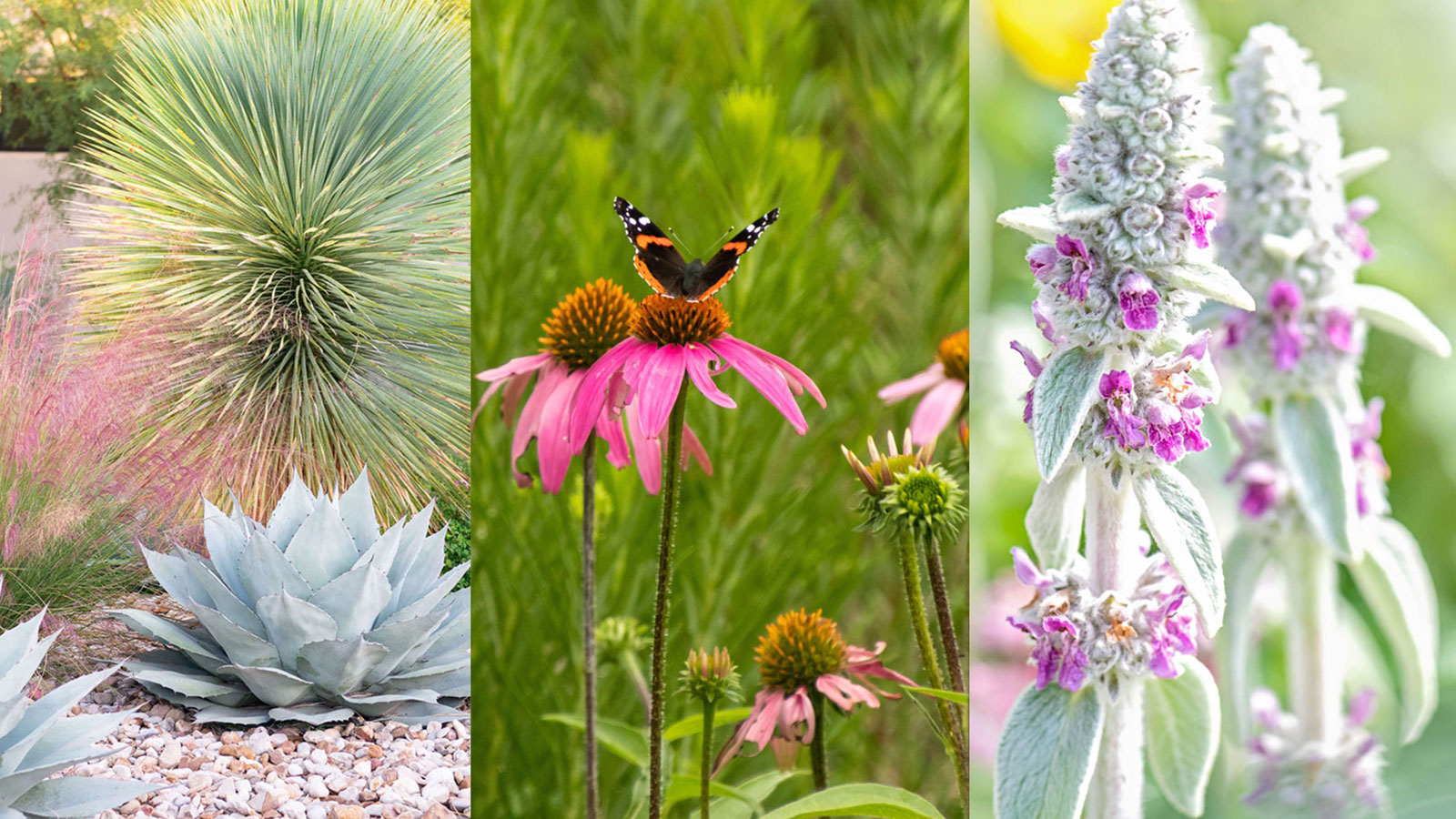

If you want to find out about low-maintenance drought-tolerant front yard ideas that look good in the heat, thrive on very little water, are sustainably sourced and provide much-needed habitat for wildlife - you’re in the right place. We think the best approach to drought tolerant landscaping is to work with what you've got and introduce changes gradually rather than opt for a radical overhaul.
Your front yard can be redesigned to need less water by making simple adjustments and building in resilience from the get-go. This means choosing plants that will thrive in dry conditions, using landscaping materials that are sustainably sourced, and being mindful of water usage. By following these easy steps it's possible to design a front yard that's both beautiful and environmentally sustainable.
Our expert evaluation takes in front yard landscaping ideas, such as greenscaping and rewilding, as well as showing how to restore biodiversity in your yard to make it resilient in times of climate change.
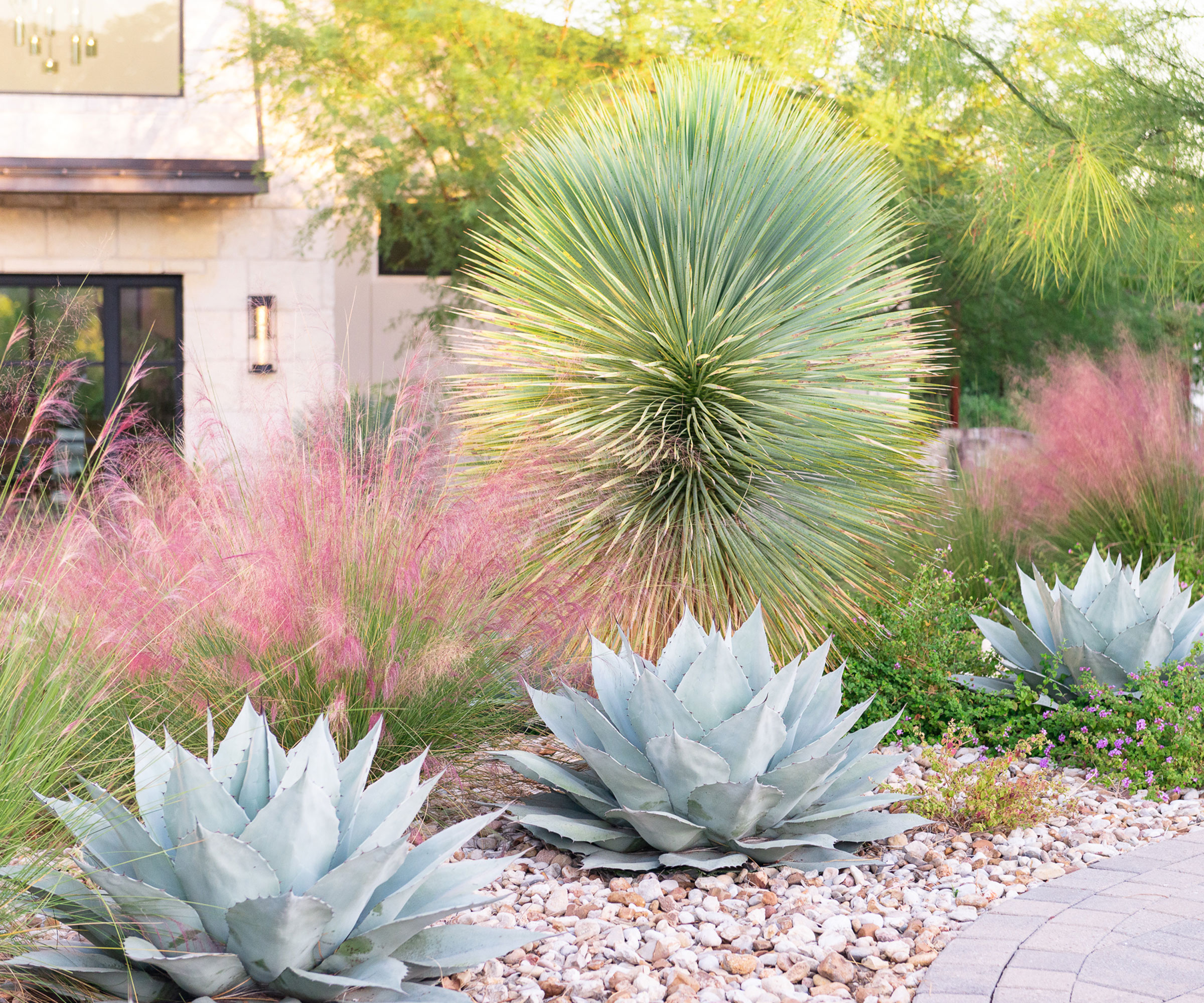
This front yard path is bordered by easy succulents in gravel beds for a drought-resistant front yard planting scheme that looks good too
8 ways to make your front yard drought tolerant
Many gardeners are choosing a more sustainable approach to garden design, that makes it more climate friendly. It's time to embrace no grass front yard ideas and reduce surface water run-off in your yard, as well as think about your footprint if you're considering an overhaul. With this in mind find out what's made it on to our own list of the best drought-tolerant front yard ideas.
1. Grow a small meadow strip in your front yard
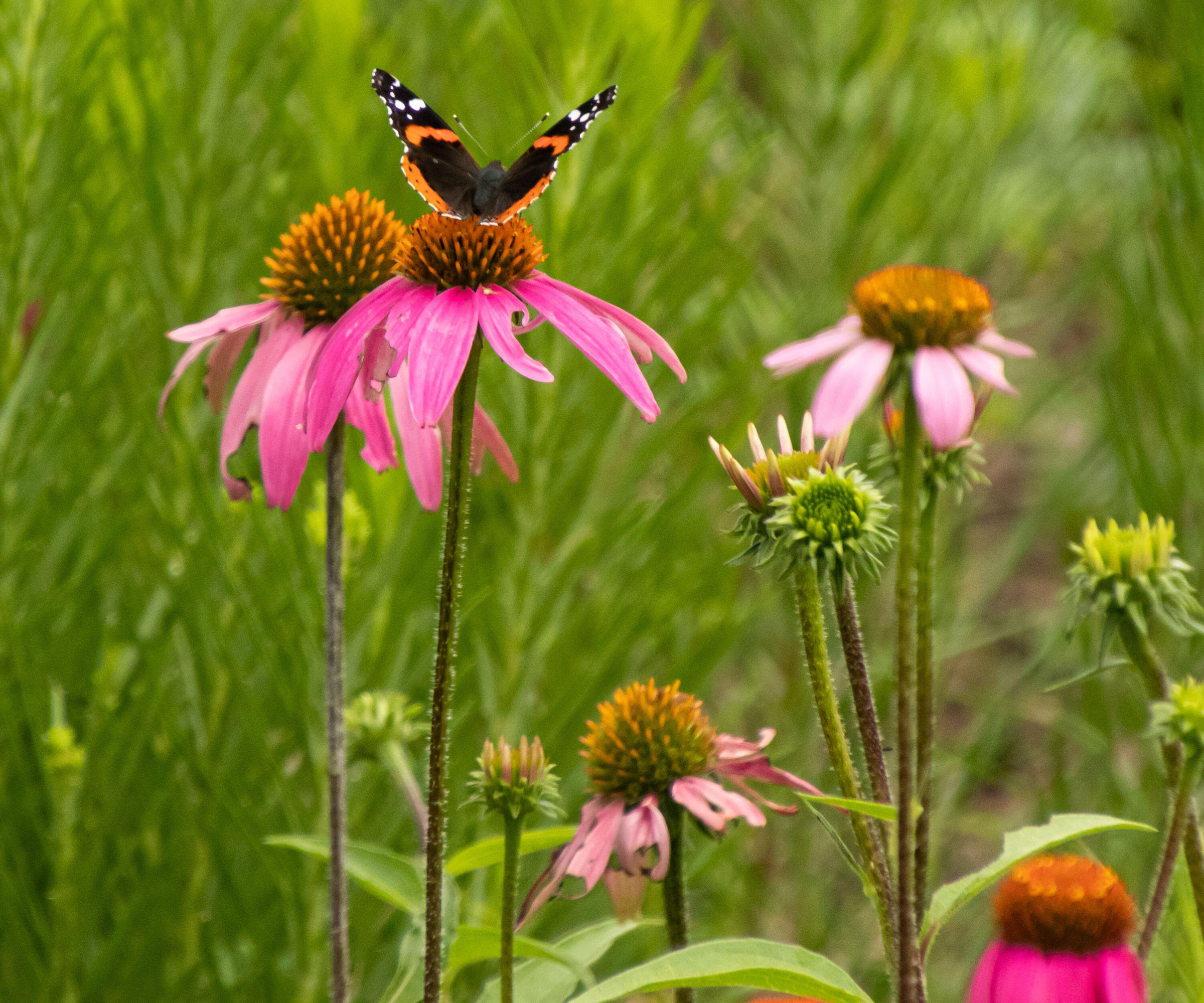
Coneflowers are a great choice for a meadow strip as they are easy to grow, flower for a long time, attract beneficial pollinators and have minimal water requirements
You can build a small scale meadow anywhere, including your own front yard. If you've already added no-mow strips to your backyard or even gone turf free think about doing the same in the front yard too.
'Consider the view of your home from the street,' says Graham Laird Gardner, author of Tiny + Wild, available from Amazon, and expert in creating high-functioning, water-smart and low-maintenance landscapes. 'Take time to assess yours and decide if your new meadow would be best sited where your neighbours can also enjoy it. Maybe this will inspire them to create their own. In this scenario, be sure to review your homeowners' association (HOA) rules regarding vegetation in the front yard.'
Graham suggests celebrating native plants to invite your surroundings into your front yard landscape. 'Native plants are adapted to local growing conditions and support your local wildlife. Prioritize species that you love coming across in natural areas nearby.' Graham suggests choosing tall native perennial plants that thrive in sun and have low water needs like Echinacea, Eryngium, Penstemon, giant milk parsley and Jerusalem sage.
Find out how to plant a wildflower meadow if you love the idea of enhancing your front yard with a beautiful wildlife habitat.

Graham has over 25 years' experience in landscape design and project management in public, private, and non-profit sectors. Beyond his residential design projects, he has worked with agencies such as the Denver Parks Department, the Rhode Island Natural History Survey, as well as many friends of parks groups and native plant societies. Graham’s diverse experience has reinforced his passion about the importance of creating a unique space inspired by nearby natural plant communities.
2. Plant a drought-resilient street tree for all to enjoy
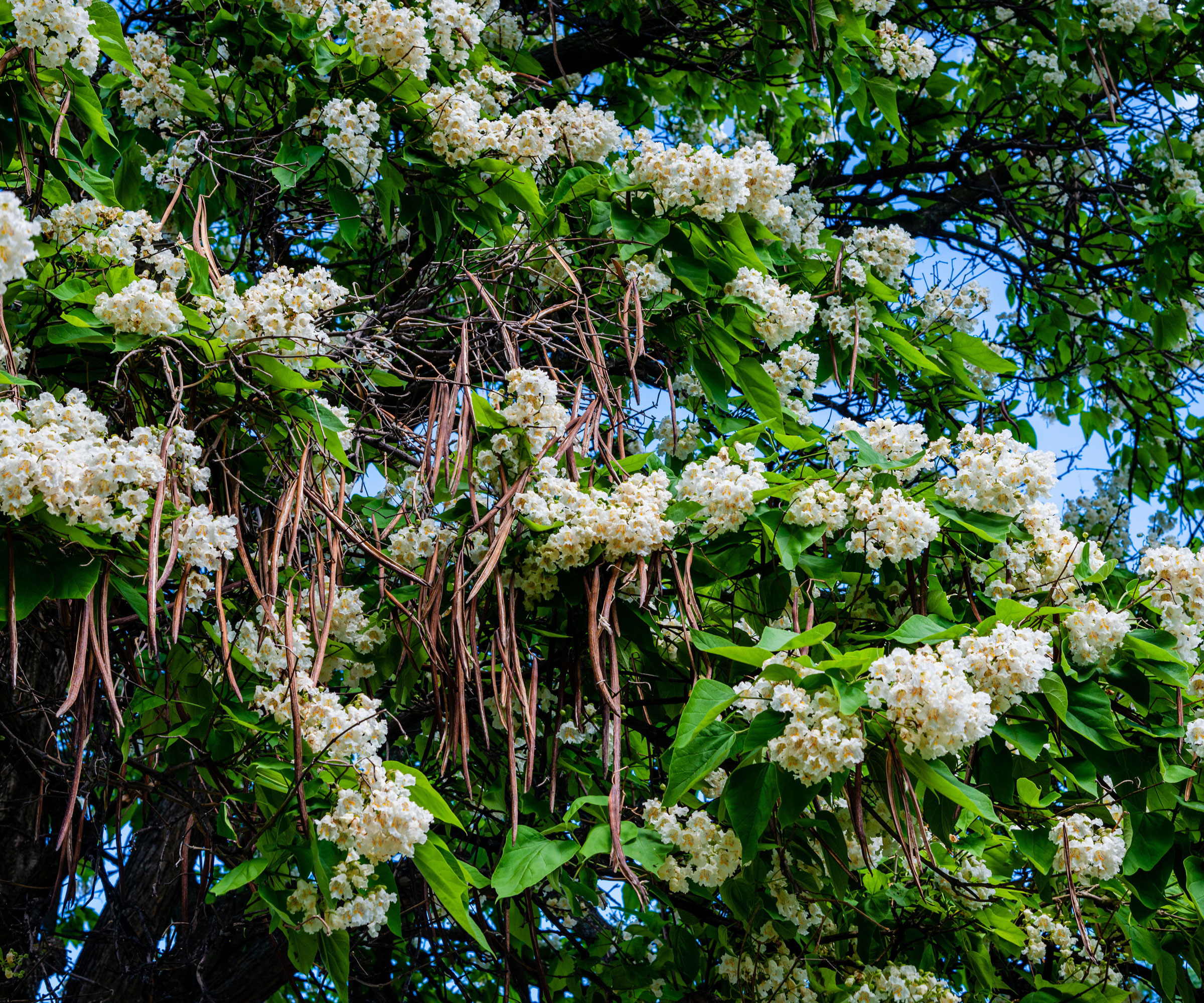
The drought-tolerant northern catalpa is also known as the Indian bean tree because of the shape of its distinctive clusters of pods
Growing drought-tolerant trees in your front yard is a great way to throw dappled shade over other plants and stopping them getting heat stressed when temperatures start to soar. Why not add a seat underneath to create a cooling space for you (and your neighbors) to enjoy.
Trees also sequester carbon, reduce pollution, shield your home from the street with a leafy green screen, and provide food and shelter for wildlife. This is all in addition to adding a beautiful focal point to your front yard.
Choose a tree that can cope with hotter, drier weather patterns as part of your drought-tolerant front yard ideas. One of our favorites is the fast growing Northern Catalpa, which has a whole show going on featuring white bell-shaped flowers, interesting seed pods up to 20 inches long, and giant heart-shaped leaves. It's native from the lower Midwest into the southern states, from southern Illinois south to Arkansas, and hardy in zones 4-8.
Find out more with our catalpa care and growing guide if you like the idea of adding this lovely specimen to your drought-tolerant front yard ideas .
3. Factor succulents and cacti into your planting design
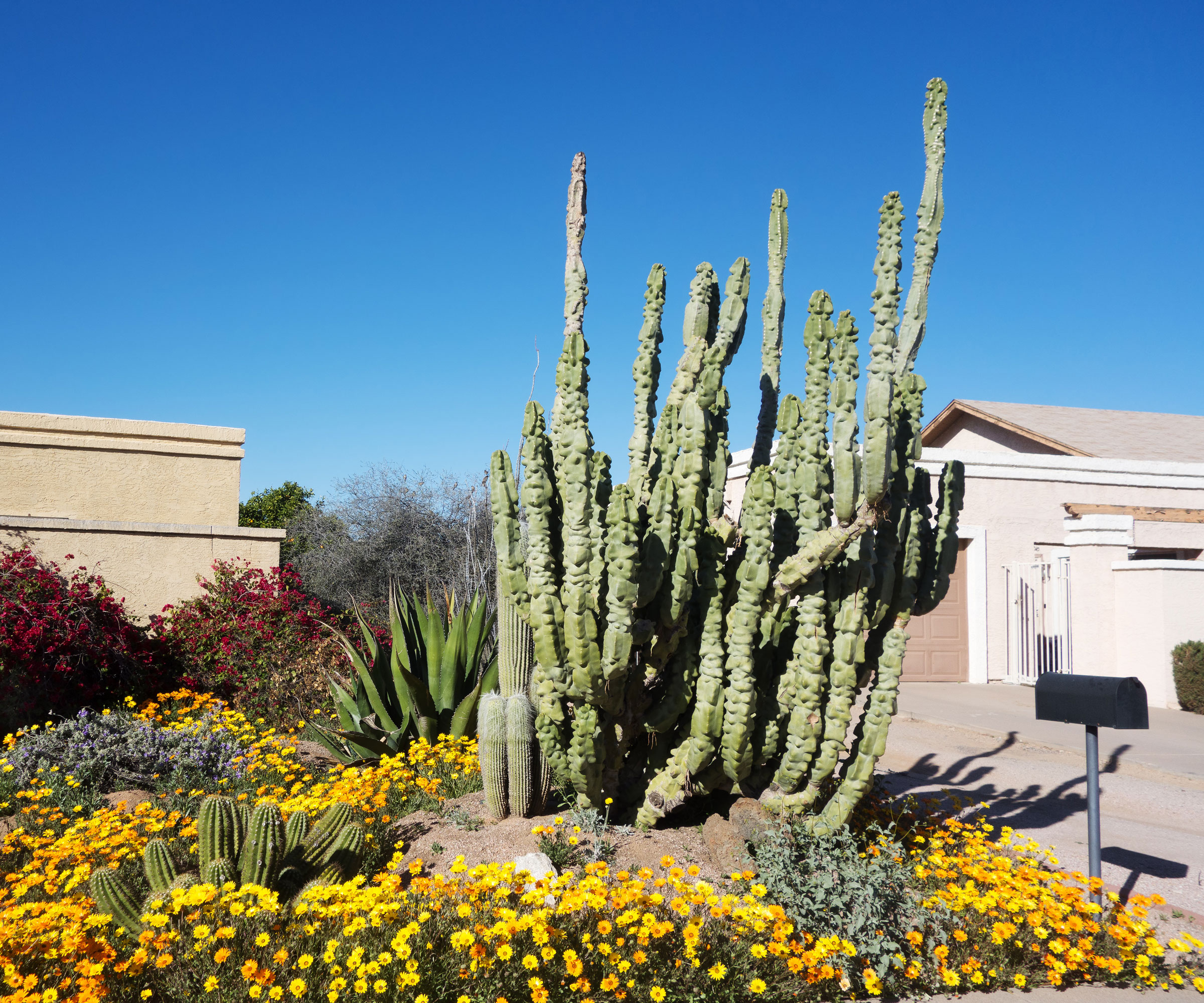
The distinctive columnar shape of the totem pole cacti (Pachycereus schottii f. monstrosus) makes it a favorite for landscaping in arid climates. It is especially good for front yards as it's thornless
Succulents and cacti are a natural choice for dry climate gardening. They offer year-round interest if you live in a warm zone, and are low maintenance too. One of the strategies that works particularly well for drought-tolerant front yard ideas is to intersperse succulent and cacti among fast growing ground cover plants and shrubs, with each type of plant enhancing the other.
'If I had to pick my favorite garden style, it would be filled with blooming shrubs and groundcovers coupled with cacti and other succulents,' says horticulturalist Noelle Johnson, author of Dry Climate Gardening, available from Amazon. 'Plants that bloom at different times of year fill my front landscape, so there is something guaranteed to be blooming in my Phoenix-area garden.'
Cacti and other succulents don’t need frequent watering because their leaves and stems are adapted to store water, so be sure to use them as an easy option as part of your drought-tolerant front yard ideas.
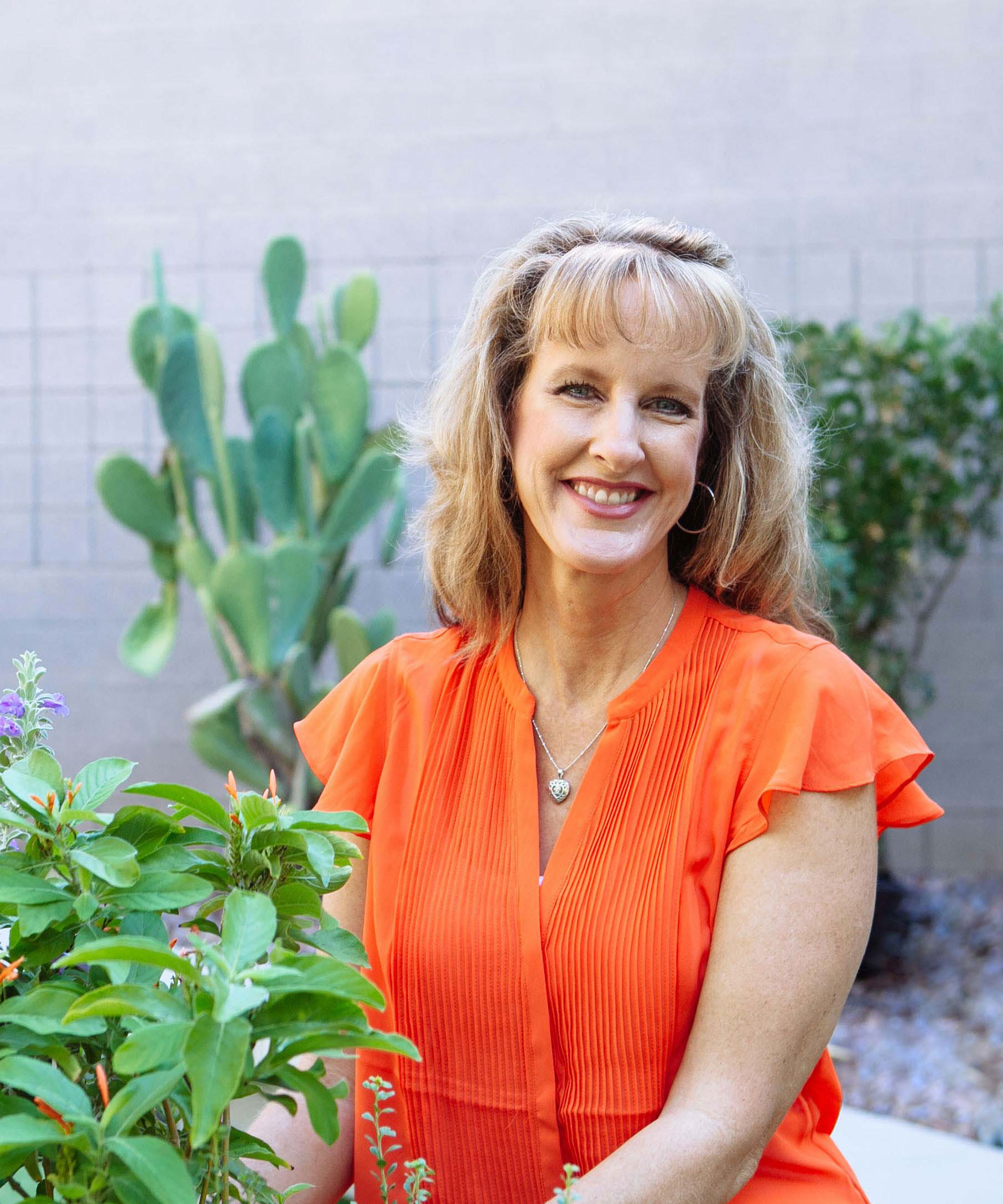
Noelle is a horticulturist, landscape consultant, and garden writer who lives in the Phoenix, Arizona, metro area. Popularly known as the 'A-Z Plant Lady,' her passion for over 20 years has been to inspire and teach people to create, grow, and maintain beautiful gardens that thrive in a hot, dry climate.
4. Landscape with the right materials to avoid run-off
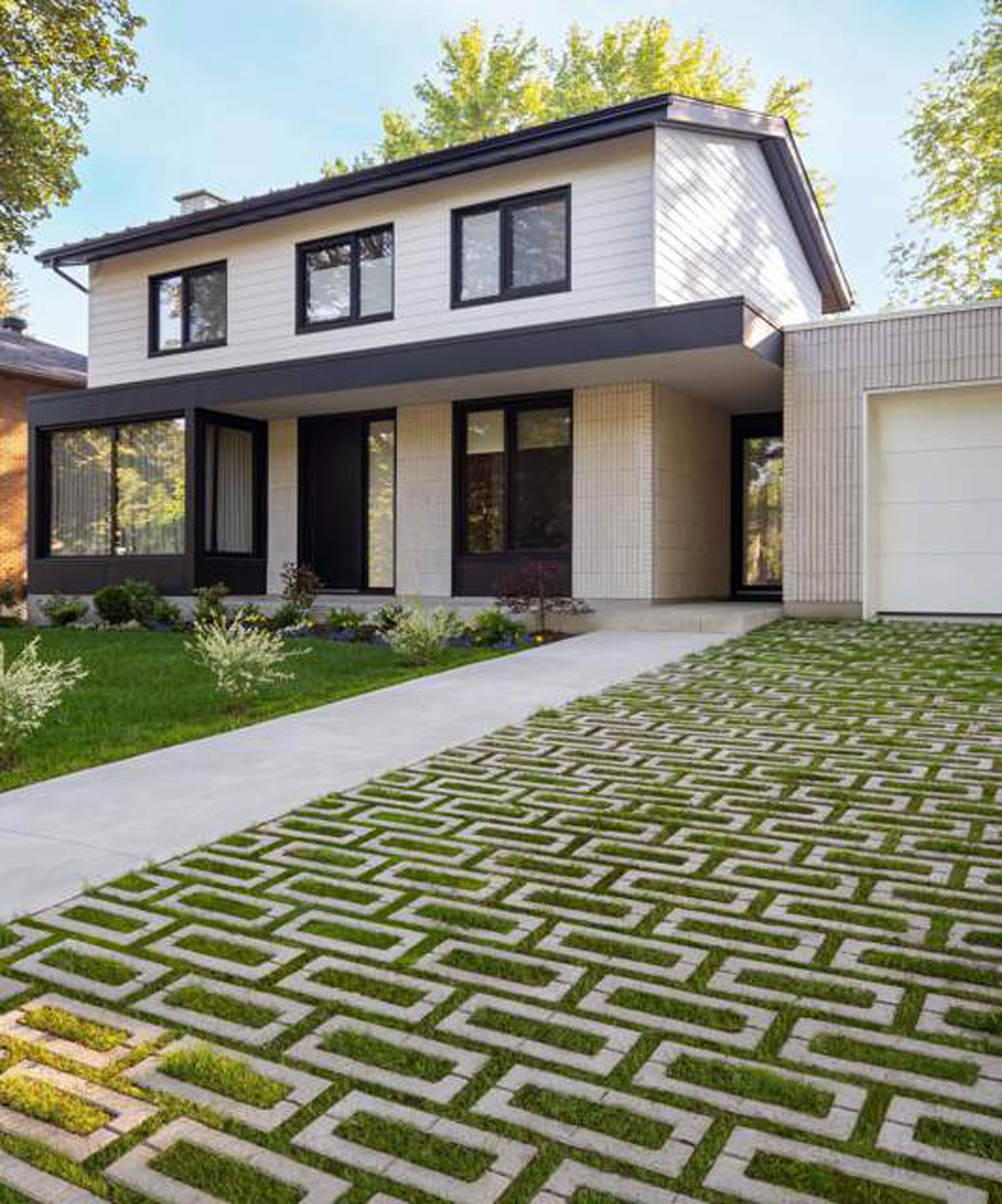
Permeable paving allows grass to grow between the pavers and rainwater to permeate through, keeping it in your yard for plant irrigation rather than running-off into drains
Water is such a precious resource so the worst thing is seeing it run off from your front yard. Try to keep any hard landscaping to a minimum when considering front yard paving ideas. When choosing what materials to use in your front yard, always put permeable paving options at the top of your list.
'Permeable paving is a porous urban surface composed of open pore pavers, concrete, or asphalt with an underlying stone reservoir,' according to the team at the Upper Midwest Water Science Center. 'Permeable paving catches precipitation and surface run-off, storing it in the reservoir while slowly allowing it to infiltrate into the soil below.'
Leaving gaps in between will also help rainwater to drain through. When surfaces aren’t permeable, rainwater runs off and can overwhelm drainage systems, thereby causing potential flooding in your area.
5. Dress soil with decorative stone options

A selection of sedums, grasses and other drought-resistant varieties are planted directly into the gravel either side and in between the pavers in this front yard path
Gravel is such a versatile material to incorporate into your drought-tolerant front yard ideas. It's a good choice for modern front yard landscaping ideas as it's a natural product, eco-conscious and affordable. Gravel also reduces water run-off and promotes better water infiltration in your front yard. Crucially, dressing the soil with gravel will hold moisture in so in times of drought your plants will be more resilient.
If you want to keep borders looking smart and contained as you welcome people to your home consider landscaping with gravel garden ideas, or alternatives such as crushed stone and pebbles. As well as looking good materials like these are a practical choice too. Use them as a mineral mulch to help soil retain moisture and keep weeds at bay. You can plant straight into them with low-growing groundcover plants, and you can also use them to break up and soften larger areas of planting.
Look out for a rock product that includes finely crushed gravel mixed with larger pieces. 'Usually called “fines”, they're available in many 1/4-inch to 1-inch landscape rock mixes,' says Noelle Johnson. 'The fines filter down through the larger rock to help form a base underneath that helps keep the bigger stone more stable and less likely to come loose onto the sidewalk.'
6. Choose a screening hedge with added benefits
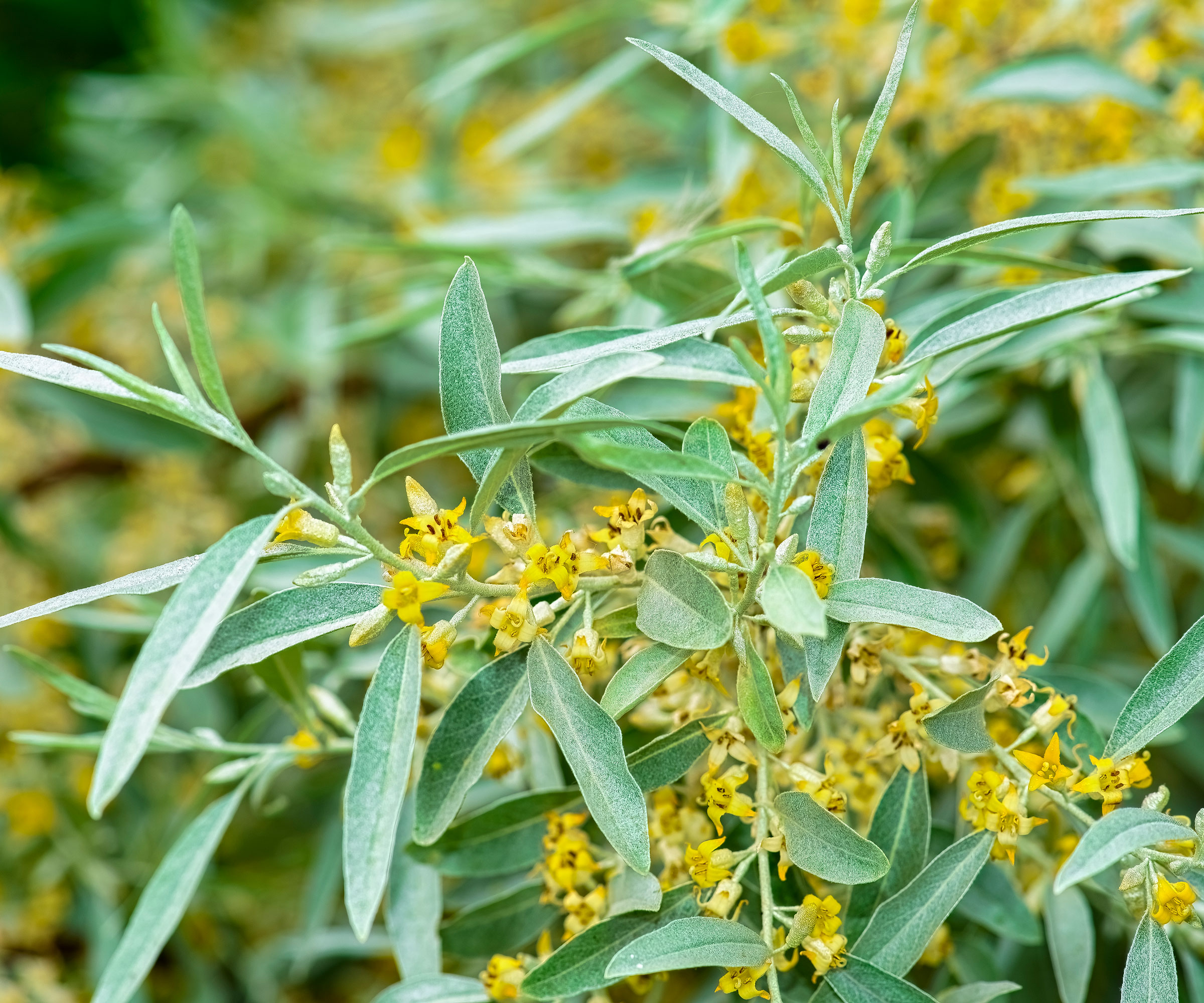
If you love the idea of a leafy screen to enhance the privacy of your front yard Elaeagnus angustifolia is a great choice
If you live in an urban area, visual screening with a hedge in your front yard is probably high on your wish list. As well as the aesthetic benefits for landscaping, a hedge can help to reduce traffic noise and mitigate pollution by filtering the air. It will also provide shelter and food for wildlife to boost biodiversity in your yard.
Choose a resilient hedge like Russian Olive (Elaeagnus angustifolia), which is one of the best front yard hedges for privacy, especially if you live in a dry climate. This silvery-leaved shrub is fragrant in spring, has sweet-tart berries, and is easy to prune into the shape you want. It likes full sun and dry, well-drained soil, so is a great choice for drought-tolerant front yard ideas in US hardiness zones 2-7.
The highly ornamental shrub Barberry (Berberis thunbergii) is another good choice for drought-tolerant screening, this time in zones 4-9. Try a variety like 'Red Rocket', which is prized for its stunning spring and fall color in shades of apricot and coral, gradually turning ruby red. It has a neat, upright shape as well making it an easy hedging choice.
7. Green up your front yard with a living roof
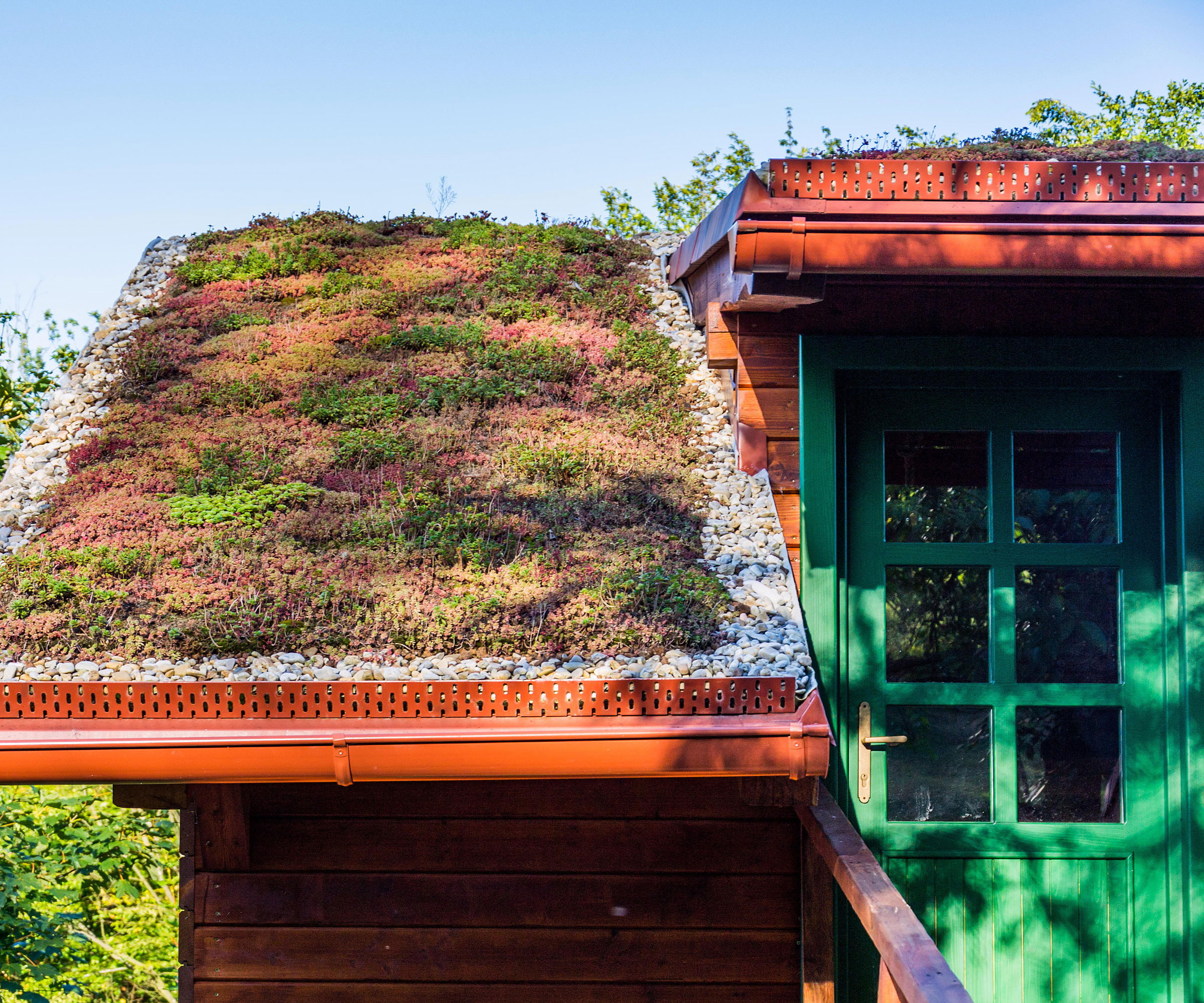
This green living roof features Sedum sexangulare, also known as tasteless stonecrop. A vigorous, creeping evergreen with succulent leaves, in summer it bears a mass of tiny yellow star-shaped flowers
One of the best drought-tolerant front yard ideas is to choose green roofs to improve the look of functional areas like garages and garbage bin storage, as well as flat extension roofs to help them blend in seamlessly with the planting scheme in the rest of the garden design.
It's a great way to green up the view from the street, as well as being biodiverse and contributing to the eco-footprint of your front yard. Additionally, green roofs absorb and retain rainfall, reducing stormwater run-off and easing the burden on drainage systems. The vegetation of a green roof will reduce pollutants, dust and carbon dioxide in the air too, replacing it with oxygen through photosynthesis.
When choosing the best plants for a green roof one of the most popular options is a low-level design using plants like sedums or other succulents to create a green carpet-like effect. You can also create a naturalistic design with taller wildlife-friendly dry habitat perennials such as Rudbeckia and Achillea, as well as ornamental grasses like Mexican feathergrass (Stipa tenuissima). The joy of both these choices is that they are drought-tolerant planting ideas as well as being low-maintenance.
8. Encourage plants to be more resilient to drought with passive irrigation
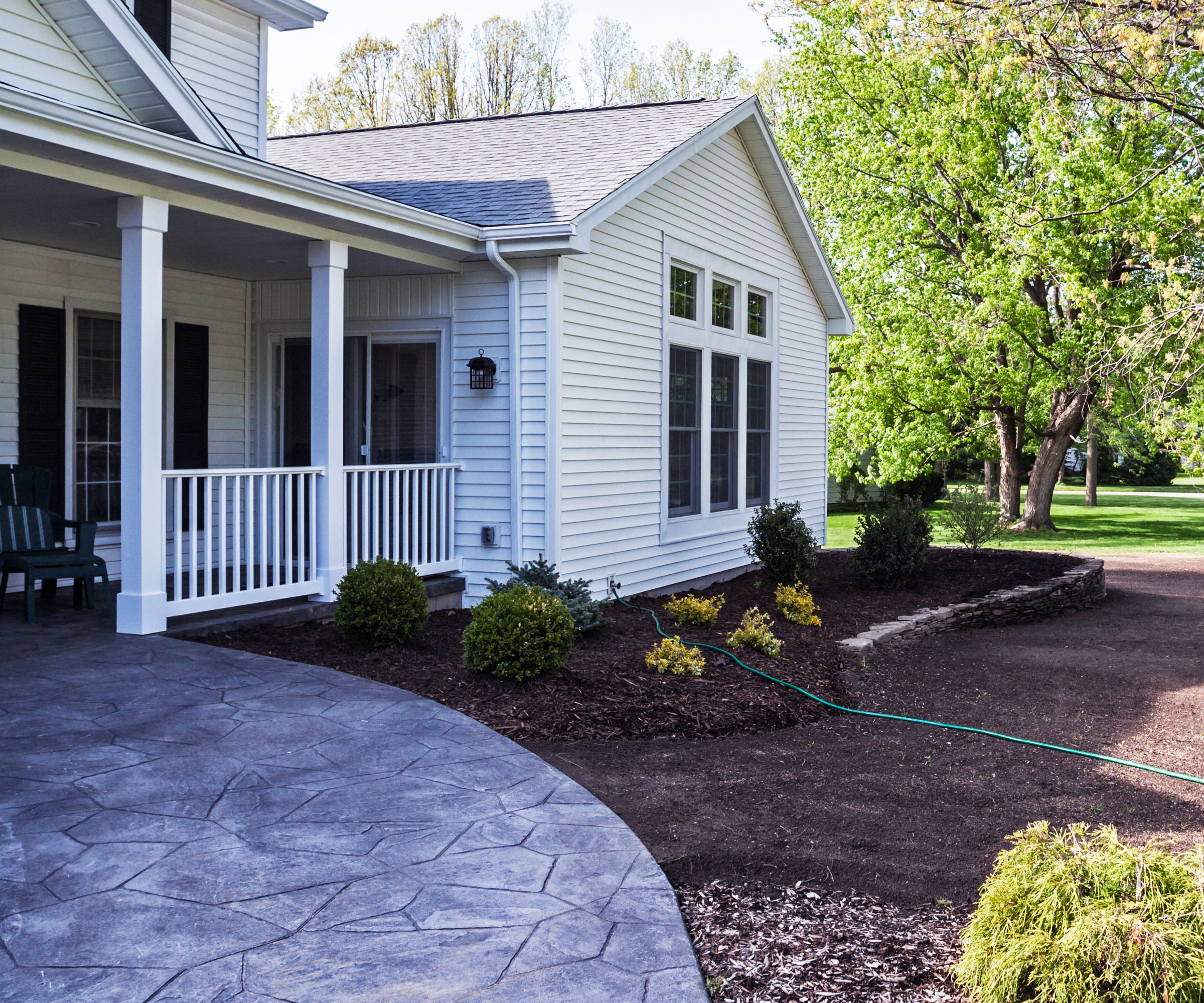
Encourage front yard plants to be self-watering wherever possible
If you live in the city your front yard will be vulnerable during periods of prolonged hot weather. By reducing run-off you can turn rainfall into a valuable resource that is key to your drought-tolerant front yard ideas. So be sure to include plenty of rainwater harvesting ideas into your front yard landscape.
The ultimate aim of a drought tolerant garden is that you never need to water it, so another idea is to encourage your plants to be resilient. Passive irrigation basically means self-watering. This approach uses gravity to get roof water to where it is most needed to hydrate your front yard landscape.
'You want your plants to have the moisture they need to thrive,' says Graham Laird Gardner, 'but you also want them to develop deep roots so they can survive on their own as they do in the wild.'
If you do have to resort to the hose the best way to do this is to water deeply but infrequently to encourage resilience. Graham suggests Identifying plants that show drought stress first. 'Typically there will be a species that will be a good indicator of when your garden needs water. Often this is a plant with large leaves that will droop during the heat of the day.' Use this as an indicator of when to water.
FAQs
How do you make a drought-resistant garden?
There are several key things you can do to make a drought-resistant garden as part of your front yard landscaping. Take time to improve the soil structure by adding organic matter such as well-rotted manure or composted bark to boost soil's water retention capabilities. If you have dry, well-drained soil choose plants that will be tolerant of these conditions.
Choose the right plants by opting for those that are adapted to thrive in drought. These includes plants with silver or grey leaves that reflect the sun's rays such as lavender and lamb's ears (Stachys byzantina), as well as those with fleshy leaves that hold moisture like sedum and other succulents. Drought tolerant ground cover plants such as creeping thyme should also be on your list. Always mulch after planting to hold moisture in the soil. Make gravel your go-to for this.
If you use small plants in your design they will develop greater resilience as they learn to adapt to dry conditions as they grow. Keep an eye on all new plants and keep them watered. Once established, they will be much more drought-tolerant.
Climate change means we're all experiencing hotter summers and less rainfall, which can wreak havoc on our yards. We're all looking for ideas and suggestions on how to rethink the way we garden and what we plant.
If you're inspired by these drought-tolerant front yard ideas take a look at our guide to xeriscaping and how to plan a dry garden for more low-maintenance eco-friendly tips. See also our guide on trees never to plant in a small front yard, to know what species to avoid in compact spaces.
Sign up to the Homes & Gardens newsletter
Design expertise in your inbox – from inspiring decorating ideas and beautiful celebrity homes to practical gardening advice and shopping round-ups.
Lifestyle journalist Sarah Wilson writes about flowers, plants, garden design and gardening trends for Homes & Gardens. She has studied introductory garden and landscape design and floristry, and also has an RHS Level 2 qualification in the Principles of Plant Growth and Development. She is a regular contributor to Homes & Gardens and Livingetc. She has also written for Real Homes, Modern Gardens and Country Homes & Interiors magazines.
-
 Bryce Dallas Howard's bedroom is the most creative, social space in her entire home – she uses 'conversational seating' to create a multifunctional 'salon'
Bryce Dallas Howard's bedroom is the most creative, social space in her entire home – she uses 'conversational seating' to create a multifunctional 'salon'The actress's bedroom doubles as a home office thanks to its clever layout and furnishings, proving that this area is much more than a sleep space
By Hannah Ziegler
-
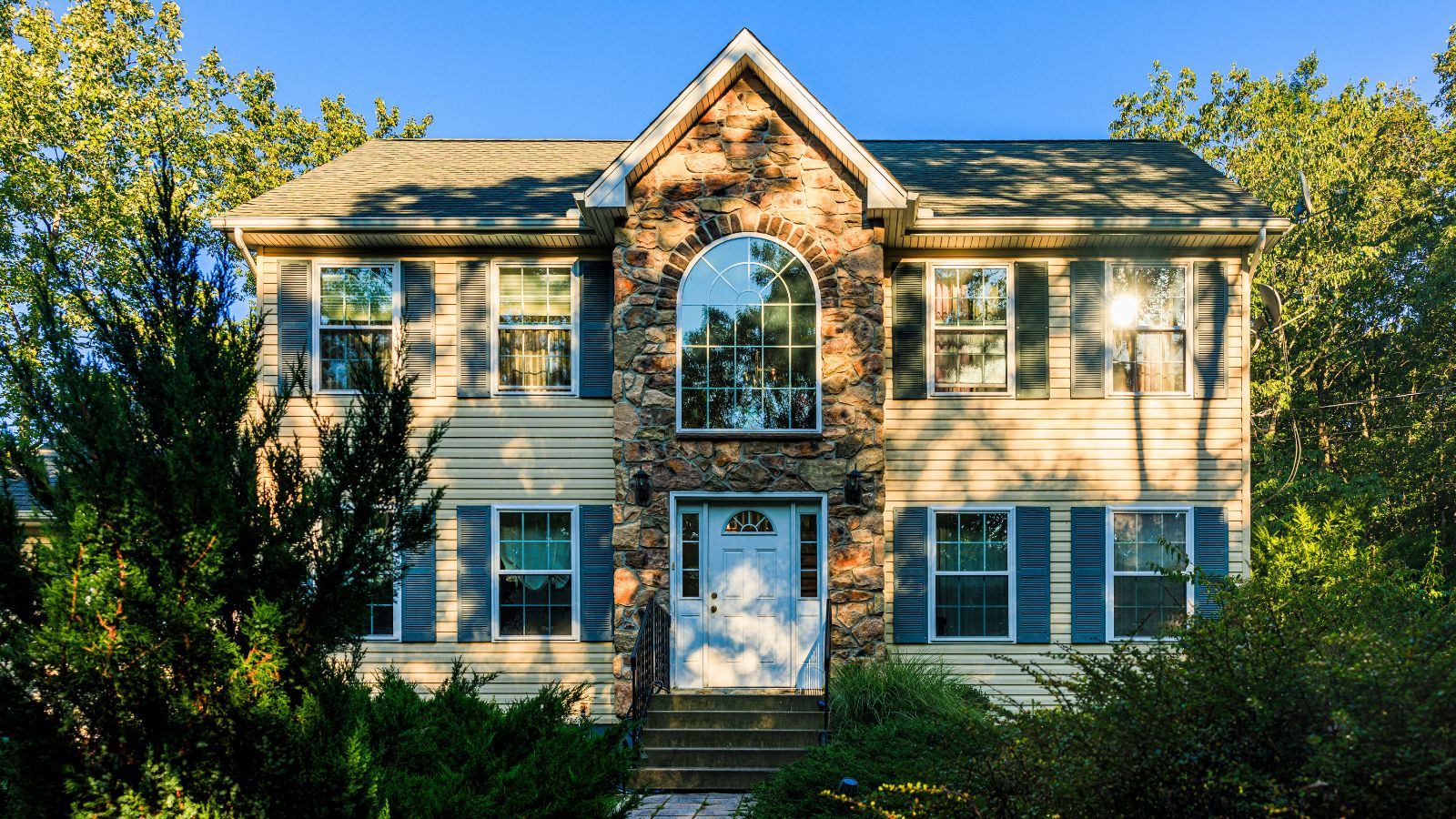 7 questions to ask yourself before moving house – realtors promise answering these questions will prevent buyer's regret
7 questions to ask yourself before moving house – realtors promise answering these questions will prevent buyer's regretDon’t make your move harder, ask these questions before moving to avoid mistakes
By Chiana Dickson